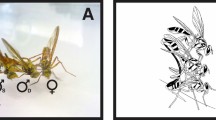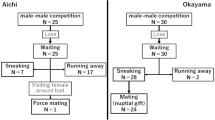Abstract
Males of the solitary bee Amegilla (Asarapoda) paracalva employ two mate-locating tactics: aggressive defense of sites from which virgin females are emerging and patrolling flower patches that are visited by conspecific females. At one study site, a single male was able to control an entire emergence area for one or more days. Multiple males patrolled one flower patch, interacting aggressively on occasion but no one individual was able to monopolize this resource. Territorial males at the emergence site secured mates by waiting by tunnels for receptive virgin females to emerge after metamorphosis. Males patrolling the flower patch pounced upon flower visiting conspecifics and mated with receptive females there. Territorial males at the emergence site were larger than average individuals, probably because of the advantage larger males have when grappling with opponents. Flower patrolling males were smaller than territorial males at the emergence sites, perhaps because of the advantages gained by these males from rapid, agile flight.





Similar content being viewed by others
References
Alcock J (1996a) Provisional rejection of three alternative hypotheses on the maintenance of a size dichotomy in Dawson’s burrowing bee (Amegilla dawsoni) (Apidae, Apinae, Anthophorini). Behav Ecol Sociobiol 39:181–188
Alcock J (1996b) The relation between body size, fighting, and mating success in Dawson’s burrowing bee, Amegilla dawsoni (Apidae, Apinae, Anthophorini). J Zool 239:663–674
Alcock J (1997) Competition from large males and the alternative mating tactics of small males of Dawson’s burrowing bee (Amegilla dawsoni) (Apidae, Apinae, Anthophorini). J Insect Behav 10:99–113
Alcock J (1999) The nesting behavior of Dawson’s burrowing bee, Amegilla dawsoni (Hymenoptera: Anthophorini), and the production of offspring of different sizes. J Insect Behav 12:363–384
Alcock J, Barrows EM, Gordh G, Hubbard LJ, Kirkendall L, Pyle DW, Ponder TL, Zalom FG (1978) The ecology and evolution of male reproductive behavior in the bees and wasps. Zool J Linn Soc Lond 64:293–326
Alcock J, Simmons LW, Beveridge M (2005) Seasonal change in offspring sex and size in Dawson’s burrowing bees (Amegilla dawsoni) (Hymenoptera: Anthophorini). Ecol Entomol 30:247–254
Blanckenhorn WU (2000) The evolution of body size: what keeps organisms small? Q Rev Biol 75:385–407
Blomqvist D, Johansson OC, Unger U, Larsson M, Flodin LA (1997) Male aerial display and reversed sexual size dimorphism in the dunlin. Anim Beh 54:1291–1299
Crompton B, Thomason JC, Mclachlan AJ (2003) Mating in a viscous universe: the race is to the agile, not to the swift. Proc Roy Soc Lond B 270:1991–1995
Emlen ST, Oring LW (1977) Ecology, sexual selection, and the evolution of mating systems. Science 197:215–223
Houston TF (1991) Ecology and behaviour of the bee Amegilla (Asaropoda) dawsoni (Rayment) with notes on a related species (Hymenoptera: Anthophoridae). Rec West Aus Mus 15:91–109
Neems RM, McLachlan AJ, Chambers R (1990) Body size and lifetime mating success of male midges (Diptera: Chironomidae). Anim Behav 40:648–652
Paxton RJ (2005) Male mating behaviour and mating systems of bees: an overview. Apidologie 36:145–156
Seidelmann K (2006) Open-cell parasitism shapes maternal investment patterns in the Red Mason bee Osmia rufa. Behav Ecol 17:839–846
Serrano-Meneses MA, Córdoba-Aguilar A, Azpilicueta-Amorin M, González-Soriano A, Székely T (2008) Sexual selection, sexual size dimorphism and Rensch’s rule in Odonata. J Evol Biol 21:1259–1273
Simmons LW, Tomkins JL, Alcock J (2000) Can minor males of Dawson’s burrowing bee, Amegilla dawsoni (Hymenoptera: Anthophorini) compensate for reduced access to virgin females through sperm competition? Behav Ecol 11:319–325
Stubblefield JW, Seger J (1994) Sexual dimorphism in the Hymenoptera. In: Short R, Balaban E (eds) The differences between the sexes. Cambridge University Press, Cambridge, pp 71–103
Székely T, Freckleton RP, Reynolds JD (2004) Sexual selection explains Rensch’s rule of size dimorphism in shorebirds. Proc Natl Acad Sci 101:12224–12227
Teder T, Tammaru T (2005) Sexual size dimorphism within species increases with body size in insects. Oikos 108:321–334
Tomkins JL, Simmons LW, Alcock J (2001) Brood provisioning strategies in Dawson’s burrowing bee, Amegilla dawsoni (Hymenoptera: Anthophorini). Behav Ecol Sociobiol 50:81–89
Acknowledgements
Thanks to Sue Alcock, Carol Simmons and Freddy Simmons for their contributions to the bee project.
Author information
Authors and Affiliations
Corresponding author
Rights and permissions
About this article
Cite this article
Alcock, J., Bailey, W.J. & Simmons, L.W. The Mating System of Amegilla (Asarapoda) paracalva Brooks (Hymenoptera: Apidae). J Insect Behav 23, 69–79 (2010). https://doi.org/10.1007/s10905-009-9196-x
Revised:
Accepted:
Published:
Issue Date:
DOI: https://doi.org/10.1007/s10905-009-9196-x




